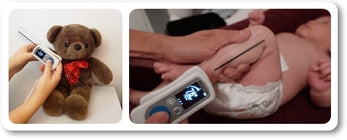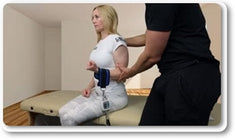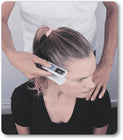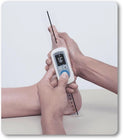Authors: Silverson OA, Cascia NG, Hettrich CM, Heebner NR, Uhl TL: University of Kentucky, Lexington, KY (2019)
Link to study: https://meridian.allenpress.com/jat/article-lookup/doi/10.4085/276-20
Number of Subjects: 17 (9 female, 8 male) all healthy participants.
Abstract
Abnormal positioning of the scapula has been linked to shoulder pathology. Quantitative measures of scapular position can provide clinicians with objective values to identify mobility impairments. Currently, scapular mobility can be measured accurately and reliably in the clinical setting using an electronic inclinometer for the motion of scapular upward rotation. Measuring scapular internal rotation and posterior tilting is limited due to orientation restrictions with respect to gravity. The objective of this study was to investigate the reliability of a new electric goniometer using an inertial measurement unit that removes the dependence on gravity for measuring scapular mobility in the three orthogonal planes during scapular and humeral motions. We hypothesized that the intra-rater reliability of a single examiner on the same day will exceed Intraclass Correlation Coefficient (ICC(1,3)) of 0.80 with a standard error of measure (SEM) less than 5°of error.
Methods
This is a repeated measure design carried out in a clinical laboratory setting. to evaluate intra-rater reliability. The right scapula of 17 healthy participants (9 females, 8 males; age: 28±15 years; height: 1.7±0.12 m; mass: 73± 18 kg) was measured by a single rater during a single testing session. Three trials of each motion were recorded. The motions included were: scapular shrug, protraction, and retraction occurred with arms at side, and humeral elevation to 120°in the scapular plane were performed in an upright sitting posture using the EasyAngle electric goniometer (Meloq AB, Stockholm, Sweden). The start and end positions of the scapula for each of the motions were recorded to determine the excursion of scapular rotation in three planes: frontal, sagittal and transverse. The motions of positive direction for each orthogonal plane were: scapular downward rotation, internal rotation, and posterior tilt. The average of three trials for each motion was assessed for intra-rater reliability ICC(1,3) (p<0.05). For each position, SEM and minimal detectable change with 90% confidence boundary (MDC90) was calculated.
Results
Overall the reliability for both start and end positions were excellent with ICC values all greater than 0.83 and SEM not exceeding 3°.

Conclusion
Based on the ICC(1,3) values for intra-rater reliability, the use of the EasyAngle to measure static scapular position proves to be a reliable device when used by a single rater in the same session. The responsiveness of this goniometric evaluation is consistent with previous studies of scapular and glenohumeral measures. Objective measurement of scapular position and excursions can provide clinicians with quantified values that will advance scapular assessment relating to shoulder pathology. Future investigation of this goniometric measurement device should focus on the reliability between raters and across days.










